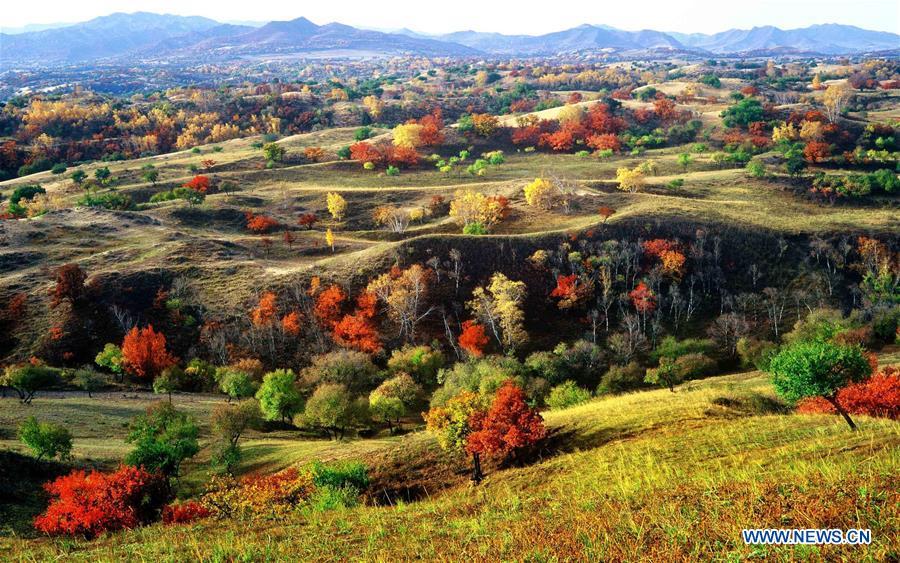
Photo taken in October 2006 shows the scenery of Hunshandake Sandland in north China's Inner Mongolia Autonomous Region. China has been delivering on its commitment to the international community on climate change by continuously shifting to a more green economy over the past years. New energy-rich regions like Inner Mongolia and Ningxia are sending more electricity generated from clean energy to the country's bustling east to help reduce the country's heavy reliance on coal in the fight against pollution and coping with climate change. China is also a leader in new energy vehicles (NEVs), with many regions across the country moving to replace their traditional gasoline-powered buses and taxis with green-energy vehicles. The country has been the world's largest NEV market for three consecutive years, with some 777,000 NEVs sold in 2017 alone. Sales in the first 10 months of this year jumped 75.6 percent year on year to 860,000 units. Thanks to increased investment in green energy, China's carbon intensity, or the amount of carbon dioxide emissions per unit of GDP, in 2017 had declined by 46 percent from 2005 levels, meeting the target ahead of schedule of a 40-45 percent drop by 2020, according to the Chinese Ministry of Ecology and Environment. (Xinhua/Zhang Ling)
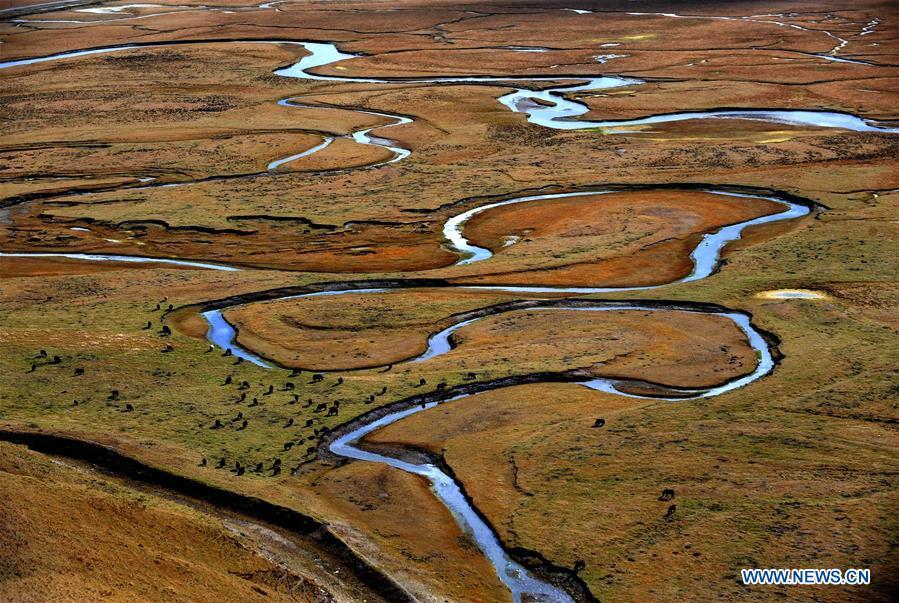
Photo taken on Oct. 22, 2009 shows the scenery of a wetland at Awancang Township in Gannan Tibetan Autonomous Prefecture, northwest China's Gansu Province. China has been delivering on its commitment to the international community on climate change by continuously shifting to a more green economy over the past years. New energy-rich regions like Inner Mongolia and Ningxia are sending more electricity generated from clean energy to the country's bustling east to help reduce the country's heavy reliance on coal in the fight against pollution and coping with climate change. China is also a leader in new energy vehicles (NEVs), with many regions across the country moving to replace their traditional gasoline-powered buses and taxis with green-energy vehicles. The country has been the world's largest NEV market for three consecutive years, with some 777,000 NEVs sold in 2017 alone. Sales in the first 10 months of this year jumped 75.6 percent year on year to 860,000 units. Thanks to increased investment in green energy, China's carbon intensity, or the amount of carbon dioxide emissions per unit of GDP, in 2017 had declined by 46 percent from 2005 levels, meeting the target ahead of schedule of a 40-45 percent drop by 2020, according to the Chinese Ministry of Ecology and Environment. (Xinhua/Han Chuanhao)

Pupils watch a TV for the first time thanks to the "Guangming" Project, which was drived by the Chinese government in 1997 to solve the power supply of no-electricity regions by developing new energy electricity generation, at a lodging primary school in Ganzi Tibetan Autonomous Prefecture, southwest China's Sichuan Province, May, 2001. China has been delivering on its commitment to the international community on climate change by continuously shifting to a more green economy over the past years. New energy-rich regions like Inner Mongolia and Ningxia are sending more electricity generated from clean energy to the country's bustling east to help reduce the country's heavy reliance on coal in the fight against pollution and coping with climate change. China is also a leader in new energy vehicles (NEVs), with many regions across the country moving to replace their traditional gasoline-powered buses and taxis with green-energy vehicles. The country has been the world's largest NEV market for three consecutive years, with some 777,000 NEVs sold in 2017 alone. Sales in the first 10 months of this year jumped 75.6 percent year on year to 860,000 units. Thanks to increased investment in green energy, China's carbon intensity, or the amount of carbon dioxide emissions per unit of GDP, in 2017 had declined by 46 percent from 2005 levels, meeting the target ahead of schedule of a 40-45 percent drop by 2020, according to the Chinese Ministry of Ecology and Environment. (Xinhua)
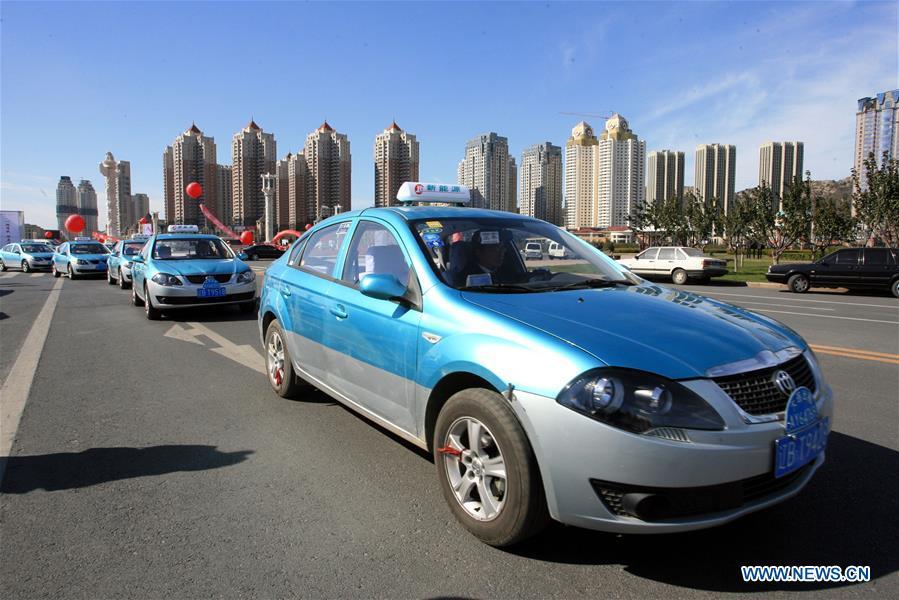
The first batch of new energy taxis are put into operation in Dalian, northeast China's Liaoning Province, Oct. 26, 2010. China has been delivering on its commitment to the international community on climate change by continuously shifting to a more green economy over the past years. New energy-rich regions like Inner Mongolia and Ningxia are sending more electricity generated from clean energy to the country's bustling east to help reduce the country's heavy reliance on coal in the fight against pollution and coping with climate change. China is also a leader in new energy vehicles (NEVs), with many regions across the country moving to replace their traditional gasoline-powered buses and taxis with green-energy vehicles. The country has been the world's largest NEV market for three consecutive years, with some 777,000 NEVs sold in 2017 alone. Sales in the first 10 months of this year jumped 75.6 percent year on year to 860,000 units. Thanks to increased investment in green energy, China's carbon intensity, or the amount of carbon dioxide emissions per unit of GDP, in 2017 had declined by 46 percent from 2005 levels, meeting the target ahead of schedule of a 40-45 percent drop by 2020, according to the Chinese Ministry of Ecology and Environment. (Xinhua/Zhang Chunlei)
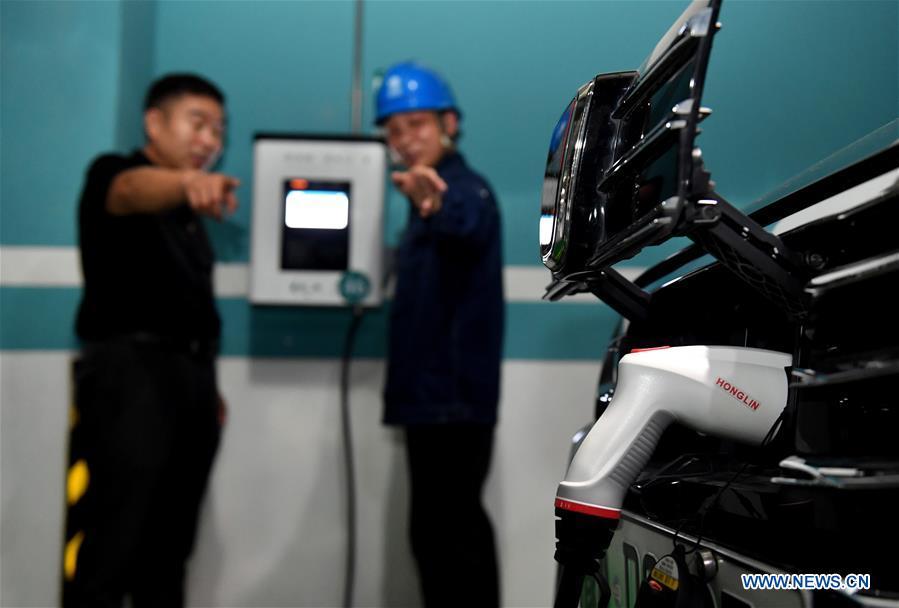
A staff introduces to a citizen the charging notice for new energy cars in Zhengzhou, capital of central China's Henan Province, July 18, 2018. China has been delivering on its commitment to the international community on climate change by continuously shifting to a more green economy over the past years. New energy-rich regions like Inner Mongolia and Ningxia are sending more electricity generated from clean energy to the country's bustling east to help reduce the country's heavy reliance on coal in the fight against pollution and coping with climate change. China is also a leader in new energy vehicles (NEVs), with many regions across the country moving to replace their traditional gasoline-powered buses and taxis with green-energy vehicles. The country has been the world's largest NEV market for three consecutive years, with some 777,000 NEVs sold in 2017 alone. Sales in the first 10 months of this year jumped 75.6 percent year on year to 860,000 units. Thanks to increased investment in green energy, China's carbon intensity, or the amount of carbon dioxide emissions per unit of GDP, in 2017 had declined by 46 percent from 2005 levels, meeting the target ahead of schedule of a 40-45 percent drop by 2020, according to the Chinese Ministry of Ecology and Environment. (Xinhua/Li Jianan)
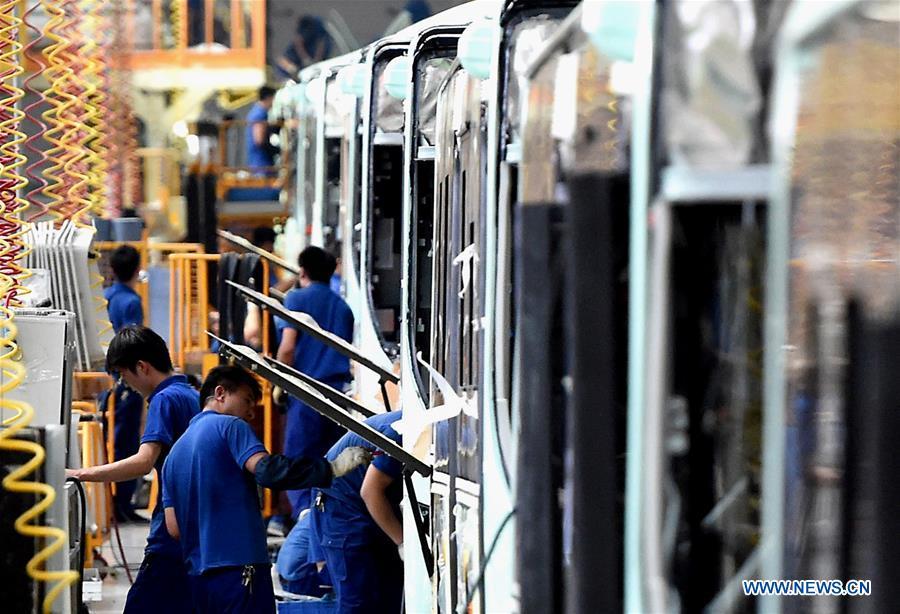
Staff members work on the production line of Yutong new energy bus in Zhengzhou, capital of central China's Henan Province, July 28, 2016. China has been delivering on its commitment to the international community on climate change by continuously shifting to a more green economy over the past years. New energy-rich regions like Inner Mongolia and Ningxia are sending more electricity generated from clean energy to the country's bustling east to help reduce the country's heavy reliance on coal in the fight against pollution and coping with climate change. China is also a leader in new energy vehicles (NEVs), with many regions across the country moving to replace their traditional gasoline-powered buses and taxis with green-energy vehicles. The country has been the world's largest NEV market for three consecutive years, with some 777,000 NEVs sold in 2017 alone. Sales in the first 10 months of this year jumped 75.6 percent year on year to 860,000 units. Thanks to increased investment in green energy, China's carbon intensity, or the amount of carbon dioxide emissions per unit of GDP, in 2017 had declined by 46 percent from 2005 levels, meeting the target ahead of schedule of a 40-45 percent drop by 2020, according to the Chinese Ministry of Ecology and Environment. (Xinhua/Li An)
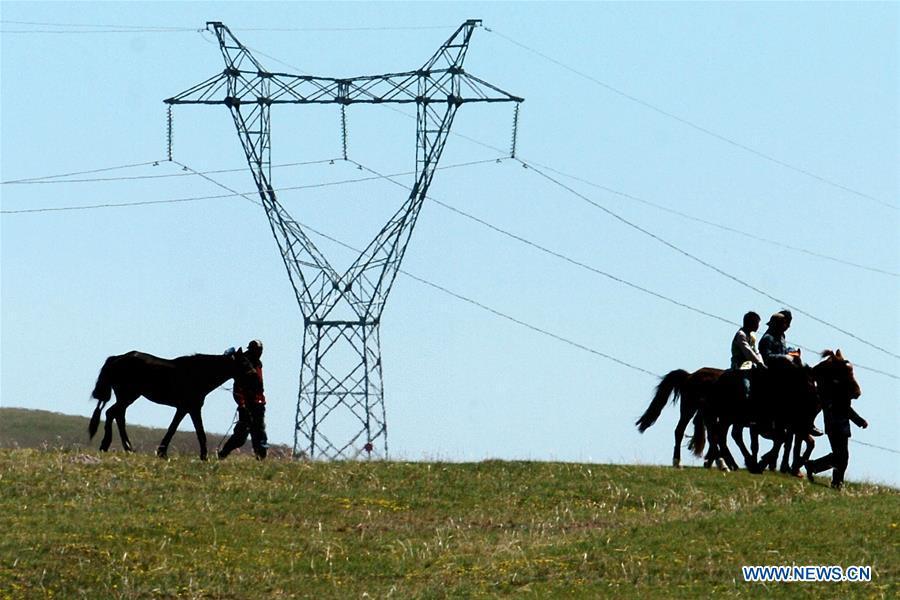
Herdsmen ride horses near a wind power plant in Hexigten Qi of north China's Inner Mongolia Autonomous Region, May 19, 2007. China has been delivering on its commitment to the international community on climate change by continuously shifting to a more green economy over the past years. New energy-rich regions like Inner Mongolia and Ningxia are sending more electricity generated from clean energy to the country's bustling east to help reduce the country's heavy reliance on coal in the fight against pollution and coping with climate change. China is also a leader in new energy vehicles (NEVs), with many regions across the country moving to replace their traditional gasoline-powered buses and taxis with green-energy vehicles. The country has been the world's largest NEV market for three consecutive years, with some 777,000 NEVs sold in 2017 alone. Sales in the first 10 months of this year jumped 75.6 percent year on year to 860,000 units. Thanks to increased investment in green energy, China's carbon intensity, or the amount of carbon dioxide emissions per unit of GDP, in 2017 had declined by 46 percent from 2005 levels, meeting the target ahead of schedule of a 40-45 percent drop by 2020, according to the Chinese Ministry of Ecology and Environment. (Xinhua/Zhang Ling)
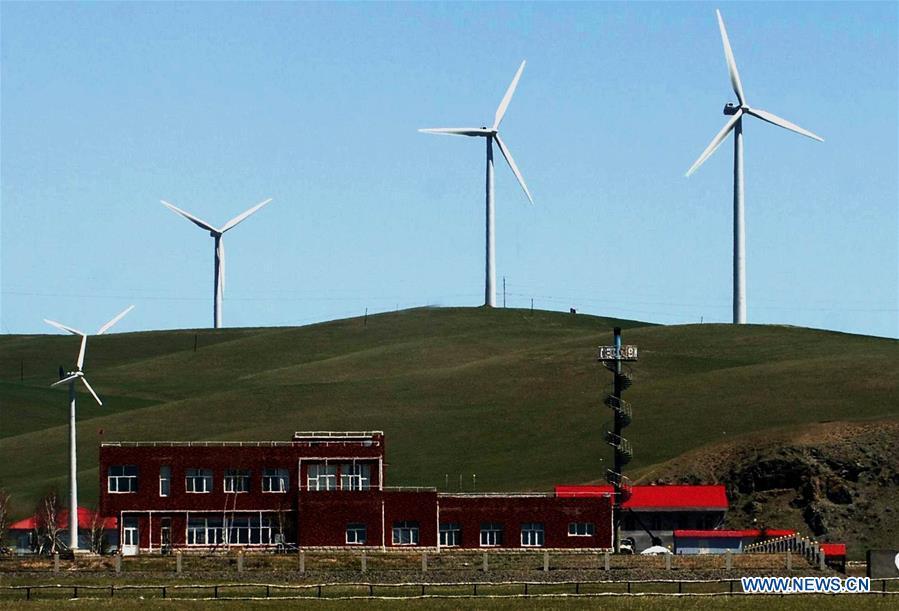
Photo taken on May 21, 2007 shows a wind power plant in Hexigten Qi of north China's Inner Mongolia Autonomous Region. China has been delivering on its commitment to the international community on climate change by continuously shifting to a more green economy over the past years. New energy-rich regions like Inner Mongolia and Ningxia are sending more electricity generated from clean energy to the country's bustling east to help reduce the country's heavy reliance on coal in the fight against pollution and coping with climate change. China is also a leader in new energy vehicles (NEVs), with many regions across the country moving to replace their traditional gasoline-powered buses and taxis with green-energy vehicles. The country has been the world's largest NEV market for three consecutive years, with some 777,000 NEVs sold in 2017 alone. Sales in the first 10 months of this year jumped 75.6 percent year on year to 860,000 units. Thanks to increased investment in green energy, China's carbon intensity, or the amount of carbon dioxide emissions per unit of GDP, in 2017 had declined by 46 percent from 2005 levels, meeting the target ahead of schedule of a 40-45 percent drop by 2020, according to the Chinese Ministry of Ecology and Environment. (Xinhua/Wang Song)
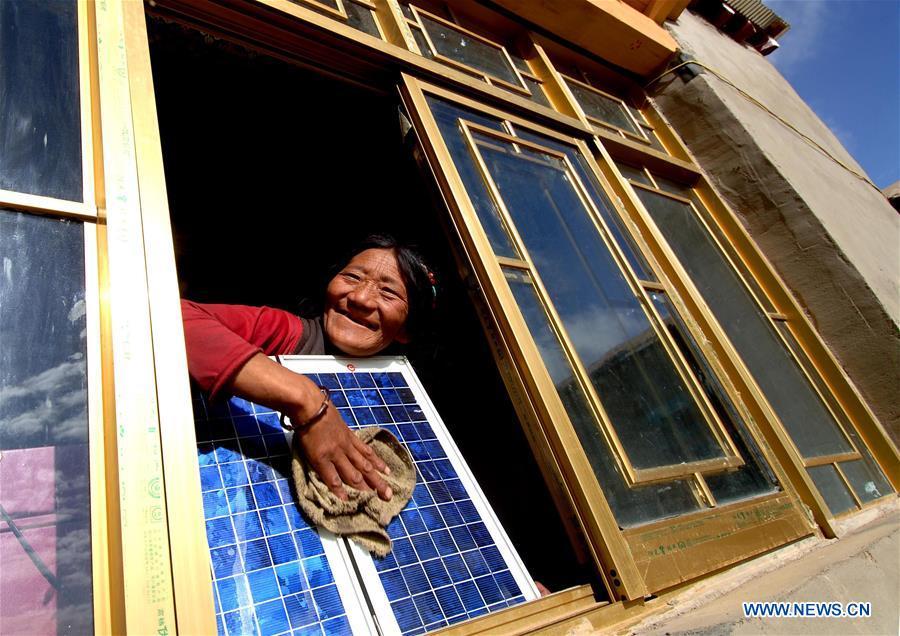
A woman cleans a solar panel at her new house thanks to the "Guangming" Project, which was drived by the Chinese government in 1997 to solve the power supply of no-electricity regions by developing new energy electricity generation, in southwest China's Tibet Autonomous Region, Oct. 12, 2006. China has been delivering on its commitment to the international community on climate change by continuously shifting to a more green economy over the past years. New energy-rich regions like Inner Mongolia and Ningxia are sending more electricity generated from clean energy to the country's bustling east to help reduce the country's heavy reliance on coal in the fight against pollution and coping with climate change. China is also a leader in new energy vehicles (NEVs), with many regions across the country moving to replace their traditional gasoline-powered buses and taxis with green-energy vehicles. The country has been the world's largest NEV market for three consecutive years, with some 777,000 NEVs sold in 2017 alone. Sales in the first 10 months of this year jumped 75.6 percent year on year to 860,000 units. Thanks to increased investment in green energy, China's carbon intensity, or the amount of carbon dioxide emissions per unit of GDP, in 2017 had declined by 46 percent from 2005 levels, meeting the target ahead of schedule of a 40-45 percent drop by 2020, according to the Chinese Ministry of Ecology and Environment. (Xinhua)
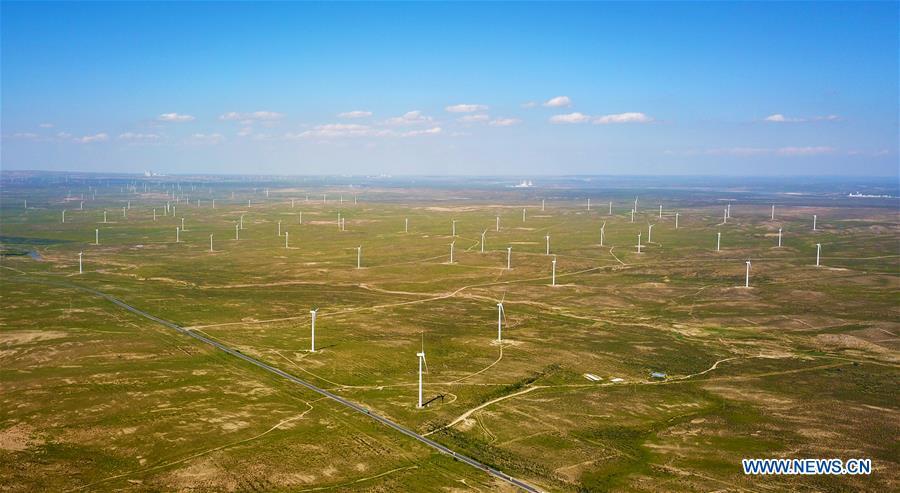
Aerial photo taken on Aug. 24, 2018 shows the Taiyangshan wind power station in the city of Wuzhong, northwest China's Ningxia Hui Autonomous Region. China has been delivering on its commitment to the international community on climate change by continuously shifting to a more green economy over the past years. New energy-rich regions like Inner Mongolia and Ningxia are sending more electricity generated from clean energy to the country's bustling east to help reduce the country's heavy reliance on coal in the fight against pollution and coping with climate change. China is also a leader in new energy vehicles (NEVs), with many regions across the country moving to replace their traditional gasoline-powered buses and taxis with green-energy vehicles. The country has been the world's largest NEV market for three consecutive years, with some 777,000 NEVs sold in 2017 alone. Sales in the first 10 months of this year jumped 75.6 percent year on year to 860,000 units. Thanks to increased investment in green energy, China's carbon intensity, or the amount of carbon dioxide emissions per unit of GDP, in 2017 had declined by 46 percent from 2005 levels, meeting the target ahead of schedule of a 40-45 percent drop by 2020, according to the Chinese Ministry of Ecology and Environment. (Xinhua/Guo Xulei)























